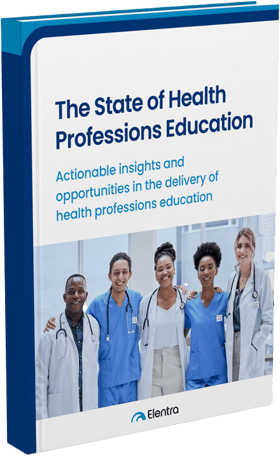The State of Health Professions Education:
Actionable Insights and Opportunities in the Delivery of Health Professions Education
The next generation of health professions education is already taking shape, and this report offers a preview of what’s coming—and what’s required to lead it. As schools rethink how they prepare the next generation of healthcare providers, Elentra's new research report reveals the evolving priorities, persistent gaps, and biggest opportunities facing academic leaders today.

Identified Trends
Drawing on input from institutions across medicine, nursing, allied health, veterinary, and more, the report identifies clear trends:
- Core strengths like clinical training, assessment, and faculty interaction remain foundational—but even these areas are being reimagined with new technologies and pedagogical strategies.
- Emerging priorities—such as personalized learning, progression flexibility, and curriculum adaptiveness—are gaining traction, yet are unevenly implemented across institutions.
- Three areas stand out as having the highest potential impact if strengthened: robust, competency-based assessment; high-quality clinical practice opportunities; and expanded use of active learning methods.
Compelling Insights
One of the most compelling trends is that every educational concept surveyed was rated as more important for the future than it is today. Educators across disciplines anticipate the need to elevate not just select aspects of training, but the entire educational experience—from curriculum design to learner support.
The report also explores a series of forward-looking innovations poised to reshape the landscape. AI-powered precision education is enabling programs to tailor content to individual learners in real time, optimizing engagement and mastery. Interprofessional education and team-based learning are becoming essential as collaborative care models become the norm. Lastly, learner support and learner well-being are taking center stage as institutions respond to rising concerns around burnout, mental health, and equity.
Summary of Findings
The report shows that while health professions education has a strong foundation in core practices, it must evolve to meet rising expectations. To prepare future-ready graduates, programs need to close persistent gaps in personalization, flexibility, and lifelong learning, while also embracing innovations such as AI, precision education, and expanded learner support.
Survey Insights
Survey results reveal that while core practices like clinical training and assessment are well-established, every educational concept was rated as more important for the future than it is today, signaling broad expectations for growth and transformation.
- What’s Currently Happening
Foundational practices like clinical training, active learning, and assessment are widely adopted, while only about 20% of programs report substantial implementation of continued education or flexible progression models. - What’s Going to Be Important for the Future?
While core elements remain essential, concepts like curriculum adaptiveness, technology integration, and learner support are expected to rise in importance—every surveyed concept was rated as more important for the future than the present. - Areas with the Biggest Potential Impact
When asked where improvements would make the biggest difference, 31% of respondents identified assessment as the highest-impact area, followed closely by clinical practice and active learning.
Takeaways: Gaps and Opportunities
The analysis identifies critical blind spots—such as lifelong learning (adopted by only 20% of programs) and progression flexibility—that remain underprioritized despite growing interest in learner-centered approaches.
- Lifelong Learning is Underprioritized
Despite its recognized importance, only 1 in 5 programs report strong support for continued education, signaling a need to better prepare learners for self-directed, lifelong learning. - Technology Integration is Uneven
Although most institutions use some form of educational technology, its adoption remains inconsistent, with many schools lacking faculty development in areas like simulation and digital learning tools. - Competency-Based Flexibility Remains a Challenge
Flexible progression is rarely implemented and ranked low in perceived impact, reflecting the ongoing tension between interest in competency-based models and difficulty in operationalizing them. - Global and Community Engagement Lag Behind
Global and community engagement ranked lowest in both current implementation and potential impact, highlighting a persistent disconnect between aspirational goals and resource-constrained realities.
Future Opportunities and Innovations on the Horizon
Educators are optimistic about innovations like AI, precision education, and interprofessional training, with many institutions already experimenting with AI-driven personalization and expanded support for learner well-being.
- Artificial Intelligence (AI) and Data
Some institutions are piloting AI-driven learning pathways, with many respondents citing AI as a key opportunity—though tempered by concerns about bias, overreliance, and faculty readiness. - Precision Education and Personalization
Programs are beginning to use data analytics to tailor content to individual learners, with initiatives like the AMA’s ChangeMedEd spotlighting precision education as a strategic imperative for the next decade. - Interprofessional and Team-Based Learning
Though still underdeveloped, interprofessional education is gaining momentum, with evidence showing it can reduce clinical errors and improve teamwork across disciplines. - Enhanced Learner Support and Well-Being
With nearly half of health professions learners reporting anxiety or depression post-pandemic, institutions are prioritizing wellness infrastructure as an essential component of effective education.
